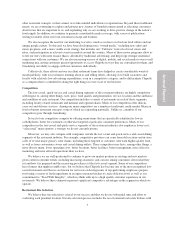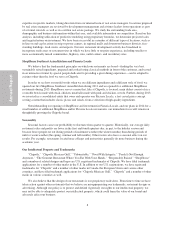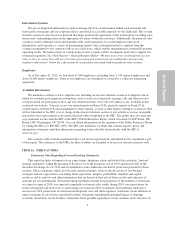Chipotle 2013 Annual Report Download - page 19
Download and view the complete annual report
Please find page 19 of the 2013 Chipotle annual report below. You can navigate through the pages in the report by either clicking on the pages listed below, or by using the keyword search tool below to find specific information within the annual report.
restaurant industry. Our sales could be impacted by changes in consumer preferences in response to dietary
concerns, including preferences regarding items such as calories, sodium, carbohydrates or fat. These changes
could result in consumers avoiding our menu items in favor of other foods, and our focus on a limited menu
could make the consequences of a change in consumer preferences more severe than our competitors may face.
Our success also depends to a significant extent on consumer confidence, which is influenced by general
economic conditions and discretionary income levels. Our average restaurant sales may decline during economic
downturns or periods of uncertainty, which can be caused by various factors such as high unemployment,
increasing taxes, interest rates, or other changes in fiscal or monetary policy, high gasoline prices, declining
home prices, tight credit markets or foreign political or economic unrest. Any material decline in consumer
confidence or a decline in family “food away from home” spending could cause our sales, operating results,
profits, business or financial condition to decline. If we fail to adapt to changes in customer preferences and
trends, we may lose customers and our sales may deteriorate.
If we were to experience widespread difficulty renewing existing leases on favorable terms, our revenue
or occupancy costs could be adversely affected.
We lease substantially all of the properties on which we operate restaurants, and some of our leases are due
for renewal or extension options in the next several years. Some leases are subject to renewal at fair market
value, which could involve substantial increases and a smaller number expire without any renewal option. While
we currently expect to pursue the renewal of substantially all of our expiring restaurant leases, any difficulty
renewing a significant number of such leases, or any substantial increase in rents associated with lease renewals,
could adversely impact us. If we have to close any restaurants due to difficulties in renewing leases, we would
lose revenue from the affected restaurants and may not be able to open suitable replacement restaurants.
Substantial increases in rents associated with lease renewals would increase our occupancy costs, reducing our
restaurant margins.
Regulatory and Legal Risks
Governmental regulation in one or more of the following areas may adversely affect our existing and
future operations and results, including by harming our ability to open new restaurants or increasing our
operating costs.
Employment and Immigration Regulations
We are subject to various federal and state laws governing our relationship with and other matters pertaining
to our employees, including wage and hour laws, requirements to provide meal and rest periods or other benefits,
family leave mandates, requirements regarding working conditions and accommodations to certain employees,
citizenship or work authorization and related requirements, insurance and workers’ compensation rules and anti-
discrimination laws. Complying with these rules subjects us to substantial expense and can be cumbersome, and
can also expose us to liabilities from claims for non-compliance. For example, a number of lawsuits have been
filed against us alleging violations of federal and state laws regarding employee wages and payment of overtime,
meal and rest breaks, employee record-keeping and related practices with respect to our employees. We could
suffer losses from, and we incur legal costs to defend, these or similar cases, and the amount of such losses or
costs could be significant. In addition, several states and localities in which we operate and the federal
government have from time to time enacted minimum wage increases, paid sick leave and mandatory vacation
accruals, and similar requirements and these changes could increase our labor costs. In addition, see “The effect
of recent changes to U.S. healthcare laws may increase our healthcare costs and negatively impact our financial
results” below for a discussion of risks related to recent changes in U.S. healthcare laws.
We also are audited from time to time for compliance with citizenship or work authorization requirements
as well, and recent audit activity and federal criminal and civil investigations in this area are described in more
detail above under “Risks Related to Operating in the Restaurant Industry—Our business could be adversely
affected by increased labor costs or difficulties in finding the right employees for our restaurants and the right
field leaders,” as well as in Note 9 “Commitments and Contingencies” in our consolidated financial statements
17
Annual Report
























